Denim trousers have gained popularity due to their practicality. This is a dense, strong fabric that consists of interlacing two types of threads. The basis of the fabric is a matrix of cotton fiber with different thread thicknesses (depending on the type of denim).

To make the fabric softer and more comfortable for daily use, a certain percentage of viscose, lycra or artificial elastin is added to it. When buying jeans, it is necessary to adjust the length to the height and features of the buyer's figure. You can shorten jeans yourself, without cutting off the bottom of the trousers.
How to determine the right length of jeans?
You can shorten jeans without cutting the bottom, without much effort, on medium-density and thin fabric. If the jeans model is made of thick material (winter collections), then you will need professional equipment for hemming. Before starting work, you need to decide on the length of the trousers. Choosing the length for women's jeans is more difficult than for men's models. Before marking, you need to put on the shoes you plan to wear the trousers with. Depending on the height of the sole and heel, the length of the product will vary.
Therefore, it is easier for men to choose the right length for shoes or sneakers, but the length of women's models will differ depending on the shoes: ballet flats or stilettos. Cropped jeans are in fashion today, so choosing their length is somewhat simplified. When marking, you need to pin the desired length at the back of the leg. It is better to measure separately for each leg, since there may be manifestations of physiological asymmetry of the figure. After marking the length, you need to walk and sit down to see if the length of the trousers is sufficient when moving.
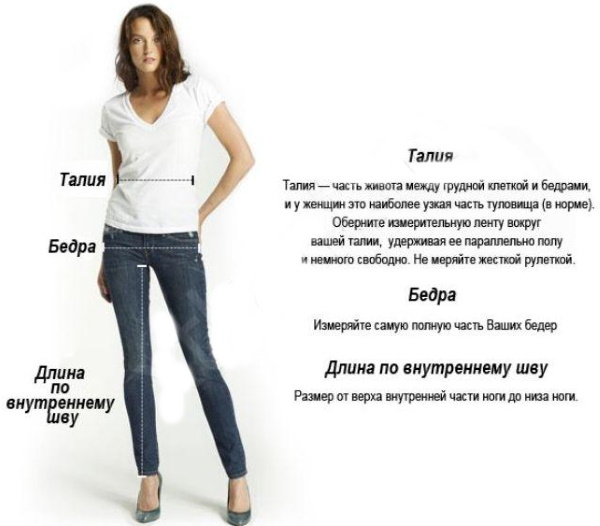
The theoretical canons of modeling state the ratio of the length and width of trousers. Therefore, the wider the trousers, the greater the length they need to be selected.
There are several standard length options for jeans:
- classic trouser length when applied to jeans implies a slight overhang of the fabric over the shoes;
- universal, which is determined without shoes and by their parameters - trousers touch the ground at the back, at the heel;
- Excess length is suitable for women's shoes with heels, when the front part of the leg forms a noticeable overlap on the foot, and the back part covers the shoe up to the middle of the high heel.
How to choose threads?
You can shorten jeans without cutting the bottom if you have high-quality threads that match or contrast with the denim fabric. As a rule, they are matched to the color of the stitching that is used to process the side or inner factory seam.
When purchasing threads for work, you need to follow the basic rules:
- For thin fabric, use thread number 50 – 60.
- For dense materials, choose No. 30 - 40.
- It is recommended to use a sewing machine needle No. 100.
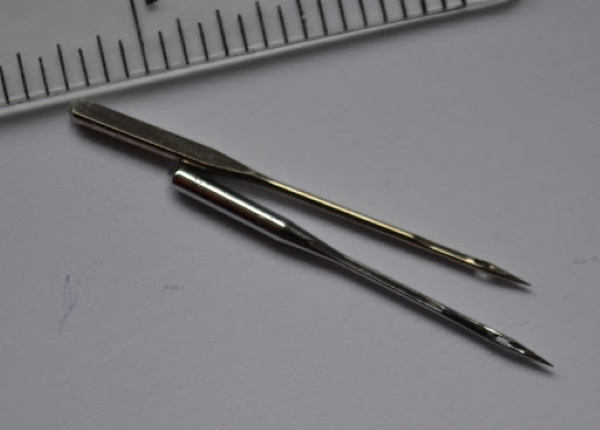
In addition to the thread number, the material and the method of production are important.
For working with denim fabric it is recommended to use:
- reinforced threads (65LH, 65LH-1 and 65 LL) – they are characterized by high fiber strength and minimal fluffiness, they have high abrasion resistance;
- polyester threads, are highly resistant to abrasion and are most often used to repair denim fabric;
- polyester – the most elastic threads, they are used to process the edges of denim fabric.
In the marking of reinforced threads, the material of the fibers from which the thread is woven is indicated using letters.
For example:
- LL - these are flax and lavsan fibers.
- LH – made of cotton and lavsan.
How to mark the hem line of jeans?
According to tailoring experts, it is possible to shorten jeans without cutting the bottom, but before work it is necessary to make careful markings. Determine the length of the trousers and the width of the hem depending on the chosen method of hemming. It is advisable to use help from the side for marking, to secure the bottom with pins in a straight standing position. When independently marking the bottom of the product, you need to look in the mirror full-face and from the side, checking the length of the product on each leg.
Methods of marking on denim fabric:
- pin and iron the lapel line;

- mark with chalk: first with strokes at the back and side, and then use a ruler to draw a straight line, laying the product out on the work table;
- “grandmother’s method” – mark a line with a piece of soap (take a piece of soap with a thin edge and draw with it like chalk);
- use a contrasting fabric marker - a felt-tip pen that will disappear after heat treatment (wet ironing or washing).
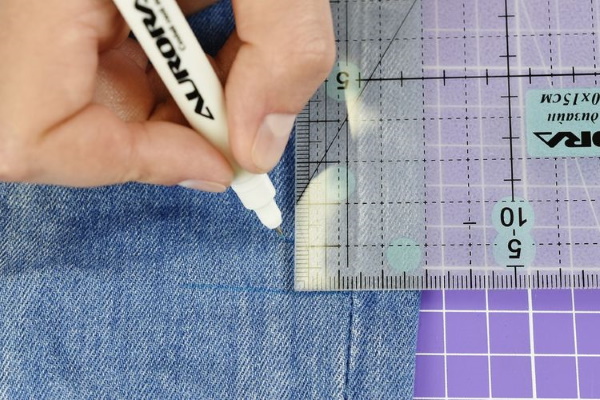
After marking, before working on the sewing machine, it is recommended to baste the seam manually and conduct a control fitting. This can be done with the threads that are planned to be used in the work, it will be possible to evaluate how the contrast seam will look on the fabric.
Methods for shortening jeans with and without a machine, step-by-step instructions
Today, both men's and women's models are fashionable not to process the bottom of the trousers with a seam, but to leave it with a decorative fringe. Due to the dense structure of the fabric, the threads at the bottom of the leg form a beautiful fringe. But if you need to change the length of the jeans, you can create an internal seam above the fringe, which will take away the excess fabric.
Shortening jeans while keeping the frayed edge
Before starting work, you need to determine the amount by which you need to shorten the trousers and make a fold on the inside. You need to baste it by hand and check the readiness by trying it on. If the length of the jeans is satisfactory, you need to stitch the seam with a sewing machine and iron the fold upwards. This way, the fringe at the bottom of the leg will remain unchanged.
Instructions for hemming while preserving the factory seam
You can shorten the length of jeans while keeping the factory seam at the bottom of the leg. It is done at the factory on special sewing machines and often the clients of the studio ask to keep it.
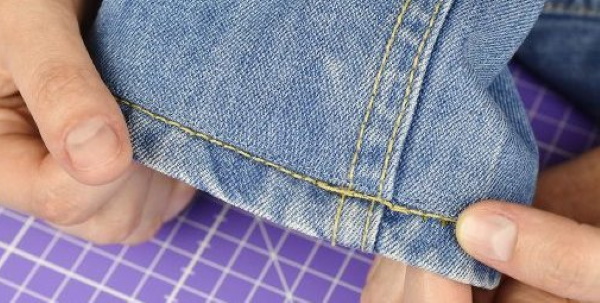
Craftsmen have developed a way to avoid cutting off the factory stitching and shorten the length of jeans:
- It is necessary to lay out the trousers with the length markings on the table (the length on each leg may be different). It is necessary to straighten the bottom of the trousers and measure the length from the bottom of the product to the hem line with a ruler.
- The trousers need to be turned inside out and mark half of the previously measured length of the hem from the edge of the decorative seam.
- The bottom of the product must be folded along the new hem line and tacked over the decorative seam.
- The jeans need to be turned inside out and tried on. If the length is ok, stitch the seam from the inside on a sewing machine.
- After turning the trousers right side out, you need to carefully iron the bottom of the garment, with the hem ironed upwards.
The secret of the method is that the extra length of the trousers is removed using a blind stitch, which is laid over the decorative edge treatment and is practically invisible. With this method of shortening jeans, it is necessary to ensure that the side seams match when hemming.
Hemming trousers with adhesive tape
You can shorten jeans without cutting the bottom using a modern sewing invention – adhesive tape. This is a kind of double-sided tape that melts during heat treatment into glue and connects 2 fabrics. To create the necessary temperature, an iron with a steaming effect is enough.
To do this, you need to buy hot-melt tape at a sewing store (it is sold by the meter):
- After marking the length, the tape is placed between layers of fabric and ironed with steam. You can use a damp cloth (ironing iron).
- The location of the tape should not just be ironed, but steamed with strong pressure on the sole of the iron. The temperature and pressure of the hot metal will melt the tape.
- After ironing, the product must be allowed to cool completely and then the strength of the hem must be checked. It depends on the density of the adhesive tape and its quality.
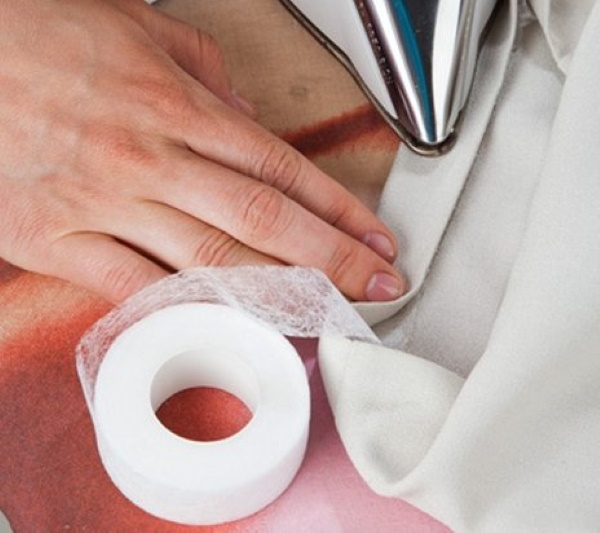
Ready.
How to hem a hem using a zipper
Using this method will strengthen the edge of the trousers and prevent them from wearing out. However, it also has its downsides - it makes the edge of summer jeans with a lot of elastin in the fabric heavier and can damage women's nylon tights.
Technology of hemming the bottom of jeans using a zipper:
- You need to measure the width of the leg at the bottom and double it, or immediately measure the bottom of the jeans leg around the circumference with a measuring tape.
- You need to buy a zipper with a length that is equal to the length of the bottom of the trousers.
- It is necessary to divide the zipper into two parts (cut with scissors and remove the lock), for work you will need only the parts with teeth.
- Before work, you need to baste the hem of the jeans or pin it and iron the new hem line.
- The part of the zipper (teeth down) should be placed on the hem so that the teeth protrude beyond the edge of the bottom of the garment. The zipper should be tacked by hand in a circle. It is better to start sewing from the side of the inner side seam of the trouser leg. Then the zipper joint will not be conspicuous.
- After sewing, the trousers need to be turned right side out and the quality of the work checked. If the zipper is sewn evenly, you can sew it on a sewing machine. The seam needs to be laid as close as possible to the zipper teeth. For such work, you can use a special foot for sewing in zippers.
This method allows you to protect the edge of the denim from abrasion and strengthens the bottom of the product, acting as a weighting agent.
Double hem
Fashion trends allow for double hemming with cuff fixation on denim. However, when constructing a cuff, it is necessary to take into account the cut of the trouser leg and the density of the fabric of the garment. Straight-cut jeans made of light, soft denim are suitable for this method of adjusting the length. When designing a cuff, 4-6 cm should be measured for its width. To be able to construct a cuff on jeans, their length should exceed the required length by 6-8 cm.
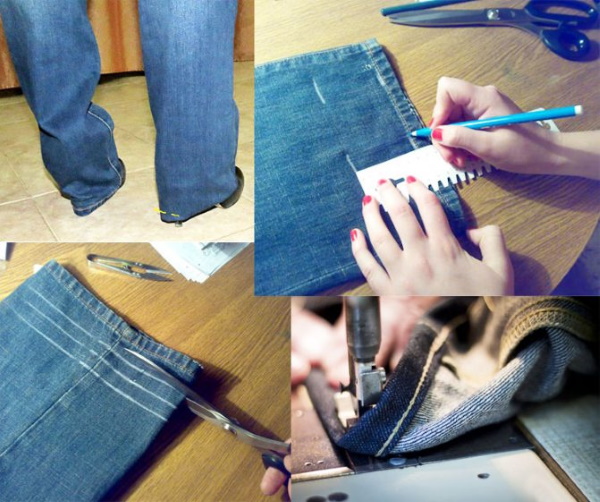
Technique for constructing a cuff on jeans:
- Before starting work, you need to put on trousers and use chalk to outline the length of the product on the front side of the fabric.
- From the marked line, you need to measure down 2 times the width of the cuff and another 2 cm. For example, if you plan to have a cuff 4 cm wide, then you need to measure down 2 + 4 + 4 = 10 cm.
- Draw a line with chalk at a distance of 4 cm - this is the fold line of the cuff.
- Along the fold line, you need to fold the fabric to the wrong side and iron it with steam (you can pin it).
- Along the marked line of the bottom of the product, you need to lay the cuff, turning the fabric to the front side of the trousers. After forming, it needs to be ironed well.
- Now, on the inside of the leg, you need to fix the free edge with adhesive tape and fix the cuff with a stitch in the groove of the inner side seam (it is done along the entire width of the cuff).
This method can be used to shorten jeans if their length significantly exceeds the required size. Then you can rationally use the entire length of the free fabric to create a stylish design for jeans. The method is not suitable for tapered and flared models of trousers.
How to shorten the bottom of pants using elastic?
This option for changing the length of trousers refers to express methods when you need to urgently shorten the product without sewing accessories. This life hack is successfully used on vacation or business trips.
Technique for turning up jeans using an elastic band:
- It is necessary to put a hair elastic on the trouser leg so that it is on the inside of the trousers.

- It is necessary to tuck the fabric under it so that the elastic is located between 2 layers of fabric along the bottom of the product. This manipulation should be performed when the trousers are put on a person and with the help of the elastic, adjust the desired length of the jeans.

- The top part of the lapel (from the wrong side) needs to be rolled down and tucked under the elastic.
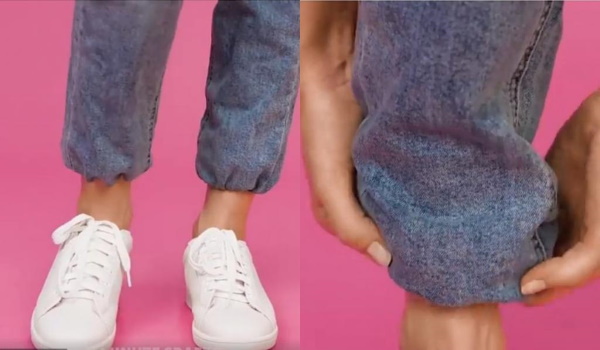
This method can be used to adjust the length of jeans made of light and medium-weight fabric. However, the trousers will gather at the bottom in random folds. When putting on jeans again, all actions must be repeated for each leg.
Hem the bottom using trouser tape
The classic version of processing the bottom of trousers from any fabric is done with a special silk tape. This method makes the hem of jeans beautiful, allows it to keep its shape when walking.
Technique for processing jeans using trouser tape:
- Before starting work, you need to mark the line of the lapel with chalk or pins. To do this, you need to put on trousers with shoes and pin the required length on the figure.
- You need to lay the trousers out on the table and use chalk (soap) and a ruler to clearly draw the bottom line of the garment, aligning it between the two side seams. This must be done using pins to see the even edge of the future garment.
- When turning up the bottom of jeans, you need to take into account the density of the fabric and add at least 4 cm for the turn-up.
- On the front side of the jeans, around the leg, you need to pin or baste a tape so that its edge extends beyond the bottom edge of the trousers (marked with chalk) by 0.1 - 0.2 cm. The tape is located below the bottom line of the product so that when the fabric is turned back, it disappears to the wrong side.
- It is better to lay the tape from the side of the inner side seam; in this place, the ends of the tape overlap each other by 1 cm.
- Then the tape needs to be sewn on a sewing machine using 2 seams. One - to lay along the edge of the tape by 0.2 cm and the second - to fix the free edge of the tape. At this stage, we have an attached tape at the bottom of the leg on the front side.
- You need to fold the bottom of the product inside out so that the edge of the tape protrudes slightly, and it is hidden inside the leg. The fold must be done along the previously marked chalk line (based on which the tape was sewn). The bottom of the product must be ironed with a steam iron.
- On the reverse side, you need to make a double flap and fix it with a decorative stitch on a sewing machine. It is recommended to choose contrasting threads for the seam.
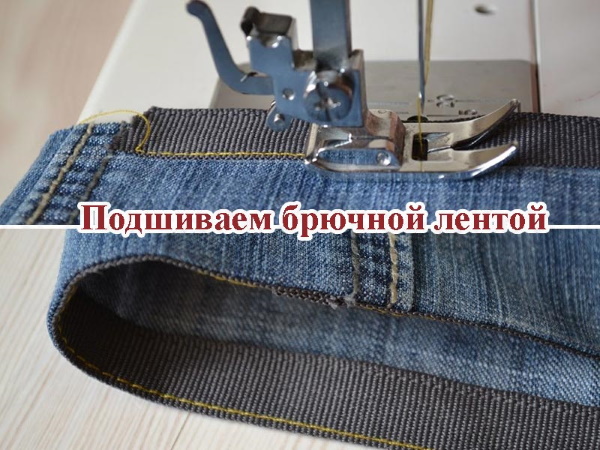
This method protects the edge of the jeans from damage and fraying when worn.
Hemming instructions
In addition to various techniques for processing the bottom of jeans, there are instructions for performing work on changing the length depending on the model and cut of the product. You can process the bottom of the trousers depending on the density of the fabric, the model of the product and the style in which the jeans will be used in the future.
To the length of breeches or shorts
Jeans can be shortened not by the length of the leg, but turned into breeches or shorts. Today, short denim shorts with long fringe along the edge of the product are a trend. When changing the model of jeans, it is necessary to carefully and consciously outline the length of the new product. Since excess fabric will be cut off, it is advisable not to miscalculate with the length of the product.
Instructions for converting jeans into shorts (breeches):
- It is necessary to mark the new bottom line of the product on the person who will wear it. This is especially important when converting trousers into shorts, since the structure of the buttocks makes adjustments to the length of the shorts.
- Using chalk or a marker on the fabric, mark the length of the garment on the surface of the outer side seam and use a second mark to mark the length along the back panel of the trouser leg. If a person has high, firm buttocks, then a straight, even line of the bottom of the garment will not work (part of the fabric will stretch upward and the bottom line along the back panel will sag slightly).
- To avoid deformation of the fabric, it is recommended to add an allowance for the back half of the jeans of about 1 cm (it is set aside in the center of the leg and is reduced to zero at the side seams).
- When designing the bottom of shorts or breeches, it is necessary to take into account the model of jeans from which the alteration is carried out. If the trousers have a straight cut, then it is necessary to narrow the legs along the inner side seam (depending on the width of the trousers, 1 - 3 cm is allowed for narrowing).
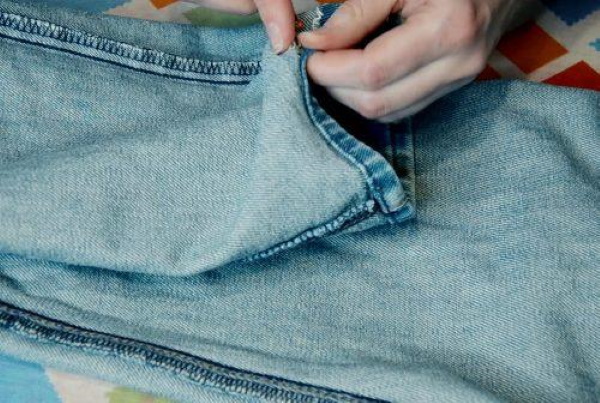
Before finally stitching the hem, it is recommended to iron the lapel and carry out a control fitting.
With wavy bottom
The decorative design of the bottom of jeans in the form of a wave or geometric slope in relation to one of the seams is done with the help of a cut-out detail, which is cut out of thick thin fabric to match the color of the jeans or, conversely, a contrasting shade.
Instructions for finishing the edge of jeans using a hem strip:
- Before starting work, you need to decide on the length of the product and the shape of the bottom line. To do this, use chalk to mark the length of the product along the outer side seam.
- The trousers are laid out on the table surface and a wavy line is drawn with chalk on the front side. From this line, a seam allowance of 0.5 - 0.7 cm is measured down.
- You need to cut off the excess fabric along the seam allowance line. You need to cut it with sharp scissors, capturing two layers of fabric on one leg. The same manipulations need to be done on the second leg.
- The fabric for hemming the product (an additional piece of the selected color) should be folded in half and placed underneath the shaped edge of the jeans. It is necessary to duplicate the wavy edge on the undercut material with chalk or a marker, then cut along the marked line.
- The front part of the undercut strip should be folded with the front side of the jeans and baste two types of fabric along the allowance line. Then you need to turn the undercut part inside out (inside the leg) and align the processed cut at the bottom of the trousers, iron with a steam iron.
- You can attach the fabric from the inside using adhesive tape or fix it with stitches along the side seams of the trousers.
This method will allow you to create an original design for the bottom of jeans or shorts, but will require additional materials and effort.
With a rough, unfinished edge
The easiest way to give jeans a stylish and original look is to create a "torn edge" at the bottom of the garment. In the same way, only with the help of scissors, you can turn tapered jeans into breeches or shorts.
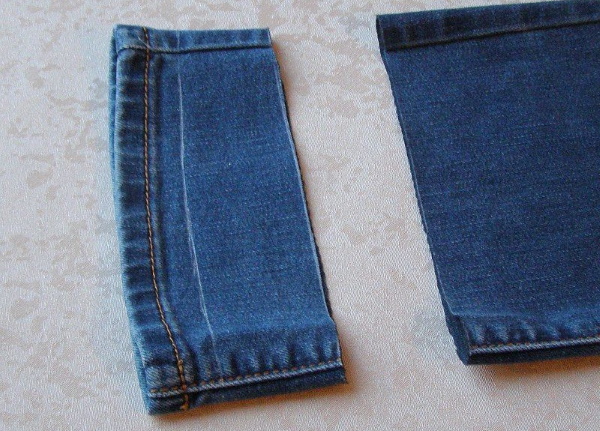
To get a "torn edge", you need to make undercuts on the side seams of the leg with scissors, 1-2 cm deep. Since they can be thickened due to the processing of the cuts and decorative seam, it will be difficult to tear the dense denim fabric in these places. Then you need to apply force and tear off the excess fabric from the panel. In some cases, the transverse threads are additionally pulled out with a needle to create a fringe.
With short fluffy fringe
This method of processing the bottom of jeans belongs to the category of "easy" work. Most of the time will be spent on creating fringe along the bottom edge of the legs.
Technique for making the bottom of jeans with short fringe:
- You need to put on trousers and mark the desired length of the product with chalk (soap, marker).
- You need to lay the trousers out on the table and use a ruler to draw a straight line that indicates the length of the leg. From there, you need to measure down 2-3 cm (the fabric from which the fringe will be made).
- It is necessary to cut off the trouser leg along the second line with sharp scissors, do not process the edge of the product.
- You need to take a regular sewing needle and gradually pull the transverse threads out of the denim. They need to be pulled out to the line that indicates the length of the product. This will result in a fringe 2-3 cm long.
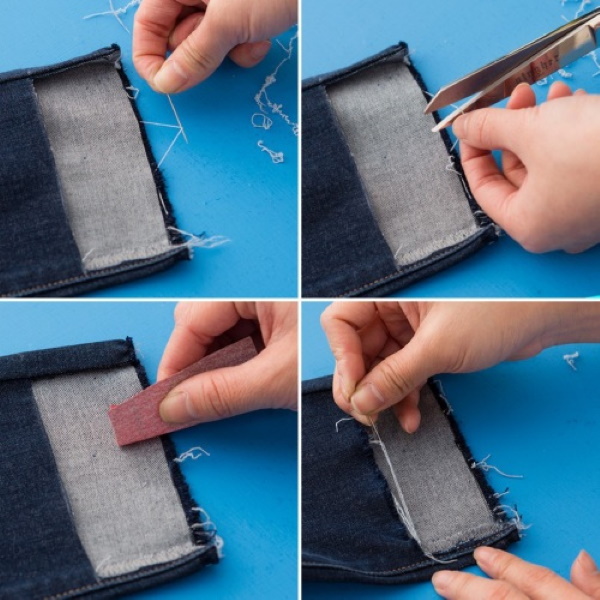
To successfully apply this method to the bottom of jeans, you need to accurately mark the length of the product, since it is impossible to correct the length later.
With long fringe
In addition to decorating the bottom of the product with short fringe, you can create a decorative design with longer threads and different shapes. For example, decorate the edge of the product along an oblique line. However, such a design will require patience and geometric markings on the front side of the jeans, according to which the transverse threads will be pulled out of the fabric. The technique for making fringe with a needle is described above in the article. Such decoration is performed on thick cotton canvases of denim.
They are easier to separate into fibers, and the fringe is voluminous. The more elastin in the denim, the more difficult it will be to achieve the "fringe" effect. Denim differs not only in color and thread composition, but also in the way they are interwoven. This determines the choice of trousers for sewing and the duration of their use.
What types of denim fabric are there:
| Fabric type | Characteristics |
| Denim | The most common type of denim fabric, in which dyed and undyed threads are interwoven, which come in different thicknesses and compositions. |
| Broken twill | A dense fabric with a complex angular weave of threads that forms a visible scar on the surface of the fabric. |
| Gin | The fabric is made of predominantly cotton fibers, soft, and easy to wipe clean during wear. |
| Stretch | The material has high elasticity, which depends on the percentage of artificial elastin threads in the fabric, is easy to clean by washing, and does not wrinkle. |
| Shambri | A thin fabric used to sew summer collections. |
| Acru | Denim fabric made from natural cotton fibers that are not dyed, dense. |
To shorten jeans using any of the methods described above, you need to decide on the density of the fabric and the length of the product. Without cutting the bottom, you can only roll up trousers made of lightweight fabric. The easiest way today is to process the bottom of the product using hot-melt tape. You don't need scissors or needles for this, you only need an iron and tape.
Video on how to shorten jeans
How to shorten jeans quickly and easily:
